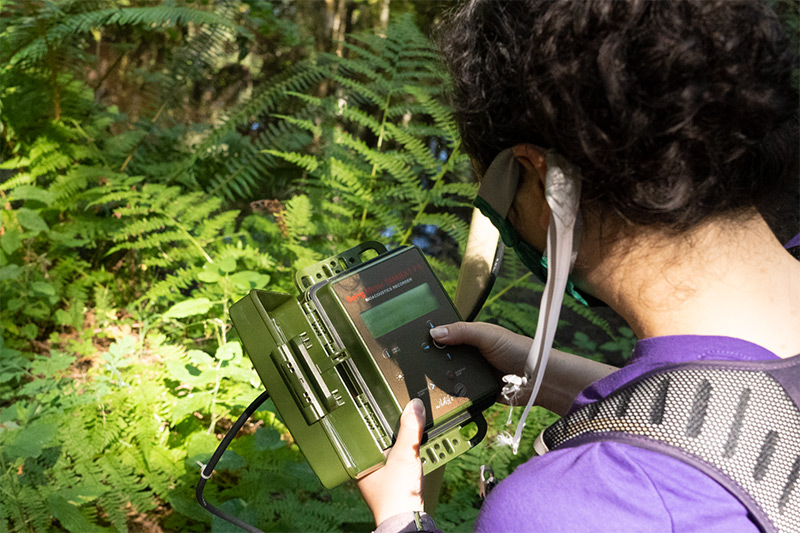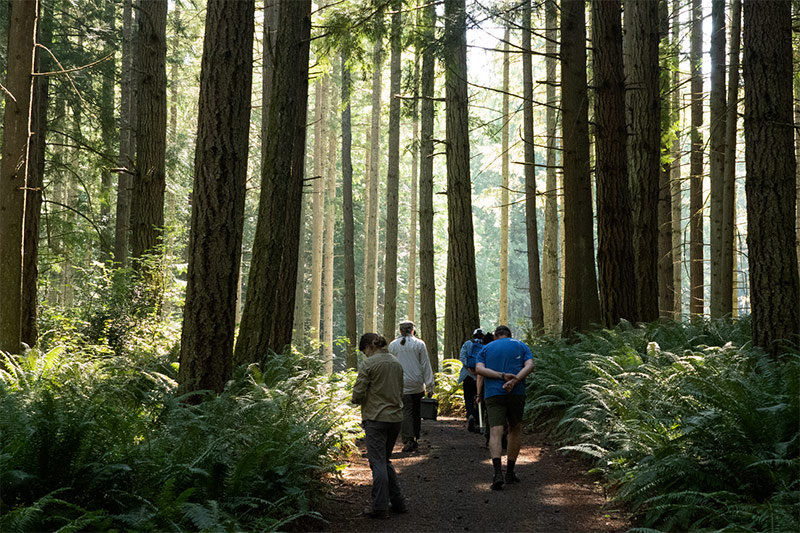WEBSITE MAINTENANCE
Our website will be offline for maintenance on Monday, December 15, 2025 from 7:00 - 9:00 p.m.
Daily admission ticket and membership purchases will still be available.
BAT CONSERVATION
Saving Bats
Bats are one of the most diverse groups of mammals in the animal kingdom. They are facing new threats, such as the emergence of white-nose syndrome (WNS), recently detected in Washington state. In addition, there are many gaps in knowledge about bats in the Northwest, particularly in urban environments, that impede effective conservation.
Monitoring Bats at Woodland Park Zoo
In early 2020, Woodland Park Zoo and Bats Northwest collaborated to place an acoustic bat monitor on zoo grounds to record the echolocation calls that bats make while hunting their insect prey. Each bat species has a unique call frequency that our collaborators from Bats Northwest analyze to determine which species are present. The bat monitor at the zoo has recorded the call frequency of 7 different bat species, out of 10 species known to occur in western Washington!
See a summary of our first five years of results
Have you found a sick, injured or dead bat? Have you seen a large group of bats?
Please report these findings to Washington Department of Fish & Wildlife to help us keep an eye on the health of our local bats!
SUBMIT YOUR REPORT
Good News for Bats

Monitoring Bat Activity
Each summer, a team that includes Woodland Park Zoo staff, Advanced Inquiry Program graduate students working with the Living Northwest program and Bats Northwest researchers participate in bat acoustic monitoring efforts on Bainbridge Island. The monitoring is part of a regional program (led by the Northwestern Bat Hub) designed to gain insights into the Pacific Northwest's bat populations. The data gathered also contributes to an ongoing North American-wide initiative, the North American Bat Monitoring Program.
See results from this monitoring
Photo by Matt Steinwurtzel / Bainbridge Island Land Trust

Community Outreach
Please join us in understanding and coexisting with bats! One of our Woodland Park Zoo Advanced Inquiry Program graduate students has compiled a great resource for learning more about bats – Bat-ivities! See what’s happening during Bat Week, every year at the end of October!
Find out about online resources on bats with Woodland Park Zoo
Photo by Matt Steinwurtzel / Bainbridge Island Land Trust
SAVING SPECIES
What are the threats to endangered bat species?
Bats are in danger. Their populations are under threat across the continents, including right here in North America. For too long the urgency of this problem has been ignored because bats are less popular and less understood than some of the other charismatic animals at the center of many conservation campaigns. But bats are essential to the web of life as pollinators and pest controllers and it’s time we take action for them!
In the U.S.
- Wind turbine disruption poses a large threat to bat populations. Partners from conservation organizations, the U.S. Fish and Wildlife Service and the American Wind Energy Association are working together to prevent further damage to populations.
- Habitat destruction, including filling in or closing off abandoned mines, urbanization (noise, light and air pollution), and human disturbance can all negatively affect roosting sites that are critical for bats as places to rest and raise their young.
Worldwide
- Myths and misperceptions about bats lead to undue fear and persecution of bats.
- Bats are collected and eaten as food in many areas of the world.
- Cave roosts are lost to improper guano mining, recreational caving and the commercial harvesting of swiftlet nests used in bird-nest soup.
- Habitat destruction, roost disturbance, and reckless eradication efforts continue to place many bats in extreme peril.
White-nose Syndrome
White-nose syndrome (WNS) is a disease caused by a fungus, Pseudogymnoascus destructans (Pd), and is devastating to hibernating bats in the United States. The fungus has also been found in Europe and Asia, where bats long ago developed a natural immunity to WNS.
Pd was first recorded in the eastern U.S. in 2006 and continues to spread across the U.S. and Canada. The resulting disease has infected multiple species and killed millions of bats. The fungus interrupts a bat’s hibernation, causing them to awaken and use up precious energy. This can cause them to leave winter roosts prematurely, ultimately starving or freezing to death. WNS also disrupts the cell structure of membranes and causes deterioration of the wing, tail, and ear membranes.
White-nose syndrome was first detected in Washington state in 2016, and the fungus and disease have since been detected in several counties among multiple species of bats. Not all species found with the fungus show signs of the disease. Bats in the western U.S. hibernate in smaller groups compared to the eastern U.S., so we are still learning how the disease will impact bats here. The White-Nose Syndrome Response Team is working to understand WNS and begin restoring these bat populations.
In 2022, Washington Department of Fish and Wildlife and Wildlife Conservation Society – Canada set up research sites across Washington to test an experimental WNS probiotic prophylaxis. The project is exploring whether applying a dust of beneficial microbes to bat roosts can help the bats survive the effects of WNS. In 2023, Woodland Park Zoo joined as a project partner to help with volunteer coordination and project communications- read more on how we are working together to protect Washington's bats.
WHAT YOU CAN DO
Be a Friend to Bats!
Share About Bats
Stay batty! The most important thing you can do to help bats is to love them. Fear and misunderstanding about bats aren’t going to help them. Educate your friends and family about all the good things that bats do for us. Read this article for a fun example of how to share positive stories about bats!
How to talk to your friends and family about bats! Use these handy talking points for social media or in-person conversations to help share your appreciation for bats! (coming soon!)
Keep an Eye on Bats!
We are empowering YOU to become a community scientist while learning more about local bat species and bat conservation issues. Why are bats important? Where do they live? Are there bats in my neighborhood? How do I know when there is a bat in the sky above me? Learn the answers to these questions and help us answer the question: Where and when are bats active around Washington.
Get involved!
MORE WAYS TO HELP